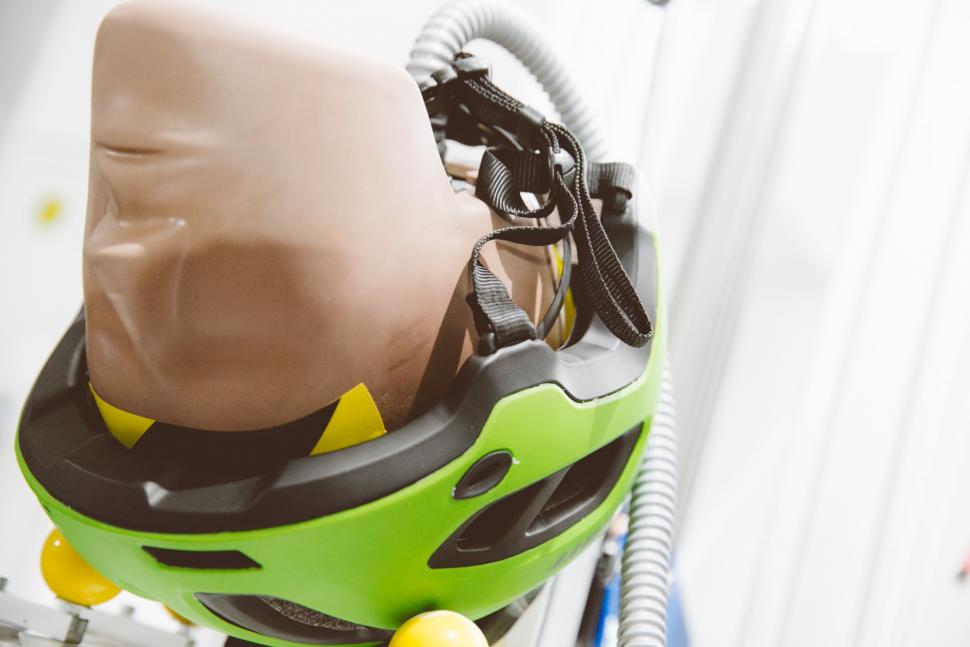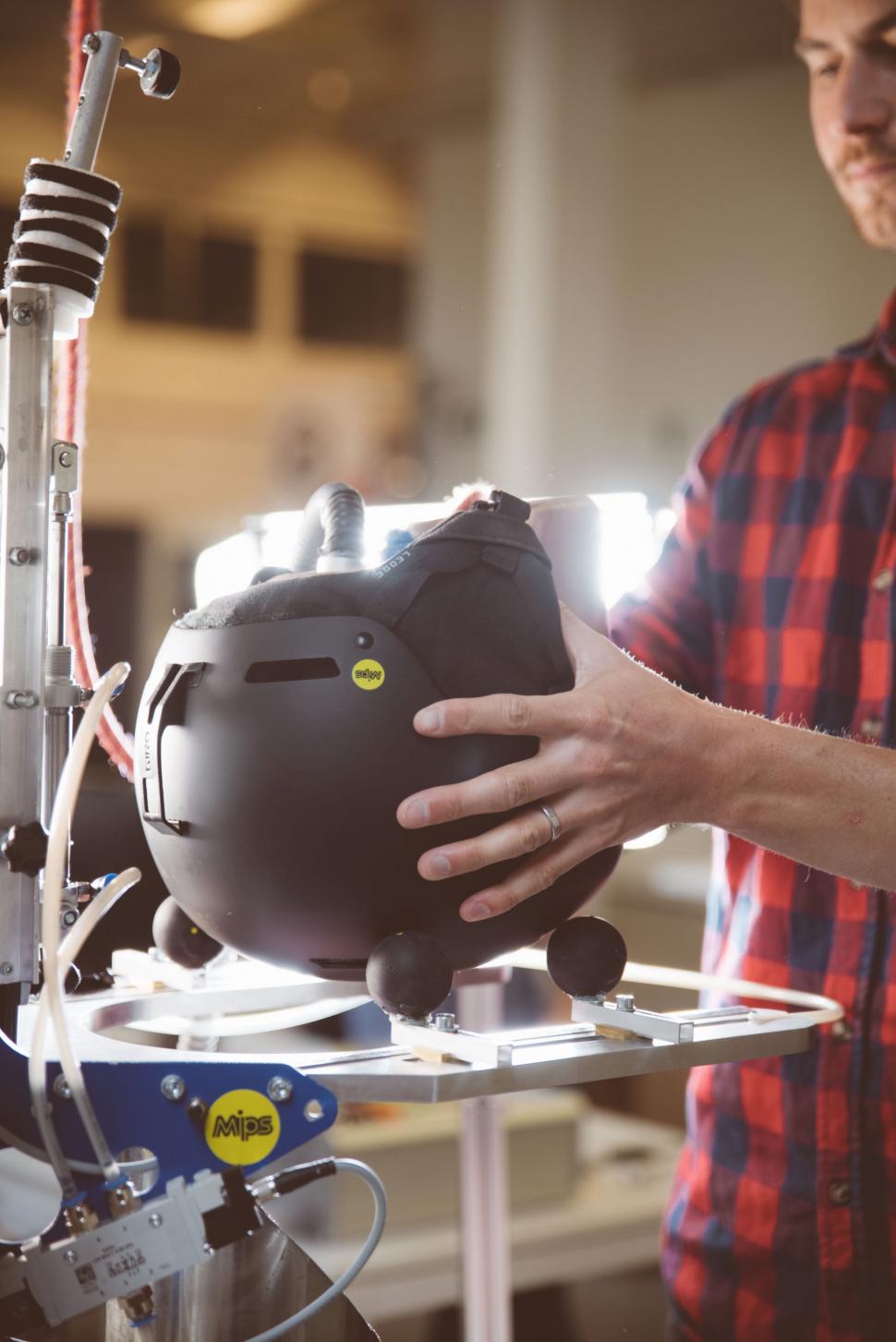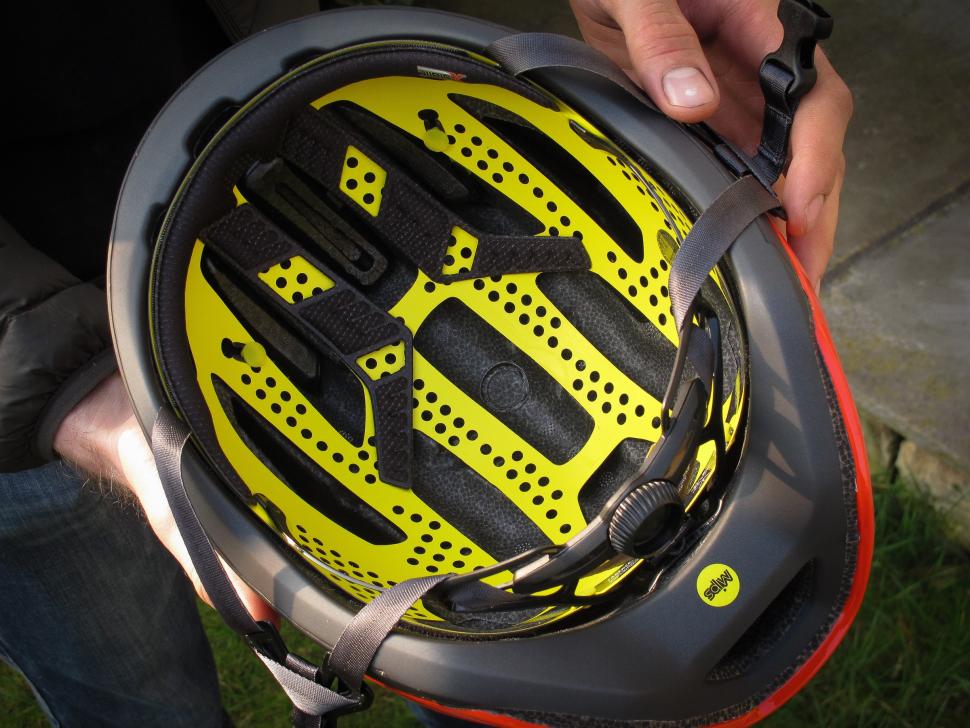- News
- Reviews
- Bikes
- Accessories
- Accessories - misc
- Computer mounts
- Bags
- Bar ends
- Bike bags & cases
- Bottle cages
- Bottles
- Cameras
- Car racks
- Child seats
- Computers
- Glasses
- GPS units
- Helmets
- Lights - front
- Lights - rear
- Lights - sets
- Locks
- Mirrors
- Mudguards
- Racks
- Pumps & CO2 inflators
- Puncture kits
- Reflectives
- Smart watches
- Stands and racks
- Trailers
- Clothing
- Components
- Bar tape & grips
- Bottom brackets
- Brake & gear cables
- Brake & STI levers
- Brake pads & spares
- Brakes
- Cassettes & freewheels
- Chains
- Chainsets & chainrings
- Derailleurs - front
- Derailleurs - rear
- Forks
- Gear levers & shifters
- Groupsets
- Handlebars & extensions
- Headsets
- Hubs
- Inner tubes
- Pedals
- Quick releases & skewers
- Saddles
- Seatposts
- Stems
- Wheels
- Tyres
- Health, fitness and nutrition
- Tools and workshop
- Miscellaneous
- Buyers Guides
- Features
- Forum
- Recommends
- Podcast
TECH NEWS
 MIPS visit - 3.jpg
MIPS visit - 3.jpgMIPS questions lack of standards for testing rotational motion in helmets
Helmet ingredient brand MIPS (Multi-directional Impact Protection System) says it is concerned by the lack of an industry-wide standard for the testing of rotational motion in the event of angled impacts to the head, and claims some systems designed to address this issue don't work to a sufficient degree.
The Swedish company designs low friction layers that are intended to allow 10-15mm of relative motion between the helmet and the head in all directions in order to reduce rotational motion transferred to the brain in certain impacts. It says it is worried that rival systems aren't as effective at protecting against damaging strains to the brain.
Find out all you need to know about MIPS 
In a crash, the forces to the head can be divided into radial and tangential forces. Most helmet testing for consumers is focused on radial forces – essentially, the ability to protect the head from skull fracture.
MIPS focuses on tangential forces which result in rotational movement, leading to diffuse axonal injury, subdural hematoma, and concussion.
“We at MIPS have conducted more than 22,000 tests and we know that not all helmets are equally safe, not even the ones that claim to address rotational motion,” says Johan Thiel, CEO of MIPS.
“Right now, almost anyone can claim that their helmet is reducing rotational motion because there is no standard they have to meet. This is serious and concerning for users who think they are buying a helmet with added protection.
“We welcome a vigorous scientific debate on all aspects of rotational motion solutions, because it needs to be a standard in place to protect the user.”
MIPS says that it is conducting extensive research on other brands' systems designed to address rotational motion and reduce strain on the brain in certain impacts, but that so far the findings indicate that, according to how MIPS and other leading test institutes in the world test for rotational motion, they do not reduce this damaging motion to a sufficient degree.
MIPS does not name these brands so we can't be certain which helmets it has in mind. POC's SPIN system features a silicone gel-like membrane inside helmet pads, the idea being to handle shearing forces – so similar to MIPS' aims. MIPS and POC last year settled a legal dispute over intellectual property, MIPS having said that POC had violated its patents, and POC having made a counterclaim. The two companies said that they had agreed to work together to develop safer helmets.
Find out about POC's SPIN system
Kali Protectives places soft gel pads throughout the interior of helmets.
"These specially designed viscoelastic gel pads are softer than EPS (expanded polystyrene) and can compress and shear in all directions," says Kali Protectives. "As a result, they reduce rotational impact forces by 25% and low-g linear impact forces by 30%."
We know of another major manufacturer that will soon launch helmet technology designed to redirect rotational energy away from your head, so it could be that MIPS is referring to this too (details are currently embargoed). MIPS also designs systems for motorcycling, snow sports, equestrian and military applications, so it's perfectly possible that it's talking about helmets from these other spheres.
Of course, it's in MIPS' commercial interest to expound the benefits of its own system, but the company points to evidence from third parties like Virginia Tech to back up its claims.
"MIPS is concerned at the level of testing and messaging employed by distinguished helmet brands," says MIPS. "The concern is less about the accuracy of the claims being made and more that there is not an industry-wide standard from third party testing organisations.
"MIPS is convinced that, with more rigorous testing, consumers can be more accurately informed about helmet safety and better understand what makes one helmet safer than others."
Mat has been in cycling media since 1996, on titles including BikeRadar, Total Bike, Total Mountain Bike, What Mountain Bike and Mountain Biking UK, and he has been editor of 220 Triathlon and Cycling Plus. Mat has been road.cc technical editor for over a decade, testing bikes, fettling the latest kit, and trying out the most up-to-the-minute clothing. He has won his category in Ironman UK 70.3 and finished on the podium in both marathons he has run. Mat is a Cambridge graduate who did a post-grad in magazine journalism, and he is a winner of the Cycling Media Award for Specialist Online Writer. Now over 50, he's riding road and gravel bikes most days for fun and fitness rather than training for competitions.
Latest Comments
- jaysa 2 sec ago
Another vote for Shimano QRs....
- AidanR 2 min 35 sec ago
It's not about "policing" the road. Riding in primary doesn't give you powers of arrest. ...
- andystow 20 min 47 sec ago
Same. I also have gone through a bunch of their tyres, and only the extralight disappointed (torn sidewall) but the standards are fantastic....
- thax1 35 min 20 sec ago
Same back then. Oh, also Codeine. https://www.dopeology.org/people/Sean_Kelly/
- chrisonabike 2 hours 18 min ago
Indeed - but it's no more inconsistent than our current road design - very often UK high streets are "for shopping" and also a busy through route....
- mike the bike 3 hours 48 min ago
If you ask the world's leading economic commentators how many people have been rescued from abject poverty by capitalism the average answer would...
- The Larger Cyclist 4 hours 12 min ago
loads of parking
- brooksby 4 hours 57 min ago
I hate it when I can't find the obvious source of a puncture.
- don simon fbpe 7 hours 1 min ago
Now, if we're talking gravel bikes, that's a whole different story. Gimme, gimme, gimme! Apologies for the Facebook link....
Add new comment
37 comments
They are stoatally different.
Thanks - I never realised how weaselly identifiable they are.
pop
pop weasel.jpg
That painting looks more like a stoat to me.
However, I can never tell the difference...
How about one of these:
https://www.facebook.com/handpaintedstuff/posts/have-you-got-a-stoat-and-weasel-recognition-kit-yet-do-you-know-the-difference-i/2054452084788249/
22279780_2054452018121589_6112705937861256373_n.jpg
As a rate of population cycling has dropped significantly in every state except Tasmania.
The data yet again proves that cycling as a modal share is dropping and has contined to drop.
KSIs in Aus were dropping at a decent level from 1971, they continued to drop further in the mid to late 80s when Aus gov decided to act upon the carnage caused by motorists. As soon as heelmets laws came in, the focus shifted to blaming the victimsand chasing thosw doing the least harm.
This resulted in a levelling off of KSIs and then a downward trend on a curve far less than previous, this is shown in the Australian gov own data.
Despite the increased safety in motors from the 90s were power steering, airbags and better crash protection for drivers and those outside were more common place along with better medical treatments, despite far fewer vulnerable road users to kill (why did the Aus gov not do more thorough analysis of cycling numbers post helmet laws and deliberately chose in one area to count on a day when there was a cycle rally passing through the count intersection??) and the helmets for cyclists, KSIs were dropping at a lower rate than previous?
Pedestrian KSI rates contine to drop further than cyclists post helmet laws, why?
Oliviers 'no evidence' on lower cyclist numbers ignores population growth for one thing but he ignores what every single person will tell you AND the data, regarding cycle use post law, that cycling as a whole particularly child cycling dropped off a cliff.
Rich cb , stop lying like Olivier, he even denies that risk compensation has any effect in cycling, he's a fucking dangerous loon employed by people with a vested interest in him to 'prove' certain things.
Maybe try caring a little less about others peoples choices to protect themselves. Let them decide for themselves if they think it is more likely that they are hit by that 1.5 ton vehicle or fall of and hit their head of their own accord. Let them decide which they are protecting from. This might be the one thing the British government has gotten right for generations; leave it up to us. No compulation/no denigration.
Please don't listen to Burt.
Whole population studies are very unreliable as there are so many other variables that cannot be excluded.
This is especially true if there are big changes in the population you are studying.
Mandatory helmet laws produce such changes thereby making whole population data worthless.
Wut? Surely the whole point of legislation is to have an effect on the whole population.
New Zealand has a compulsory helmet law with nearly 100% compliance. Their bicycle use and accident and fatality rate is almost exactly the same as the UK which doesn't have a compulsory helmet law.
Interestingly, I was watching an Australian paramedic show the other night when they attended a motorbike crash. The paramedic made the comment that with the way motorbike helmets were constructed you'd think they'd save the head inside it and they don't.
The effect the legislation has is different on different groups.
Imagine there were only 2 types of cyclists.
1. Road cyclist, always wears a helmet.
Mandatory helmet law has zero effect.
2. Occasional utility cyclist, doesn't wear a helmet as it messes up his hair.
Mandatory helmet law stops his cycling completely.
The cycling population pre law is 50% road, 50% utility. Post law it's 100% road.
This creates the bizarre situation where road cycling could actually get safer yet the national statistics could get worse. (If road cycling were a higher risk activity than utility cycling.)
When studying the effect of anything it's vital to keep other variables to a minimum.
Whole population studies can't do this hence why they are considered very weak evidence.
So you're saying that even though there is no evidence of a population level reduction in head injuries, the unintended consequences of implementing a compulsory all age helmet law by reducing utility cycling (the evidence in New Zealand and Australia is that children biking to school has almost completely stopped), is evidence that population level studies are unreliable?
No. I'm saying that population level studies are unreliable because you cannot control for the huge number of variables at play.
Going back to the hypothetical scenario I described earlier.
Imagine that pre law the road cyclists had 50 head injuries per 1m miles and the utility cyclists had 0.
If both groups did the same number of miles the overall rate of head injury for the whole population would be 25 per million miles cycled.
After the law there are no utility cyclists and the injury rate for the road cyclists has fallen slightly to 49 per million miles cycled.
Nationally the number of head injuries per million miles will have increased hugely (to 49 from 25) and even the number of head injuries in total won't have changed much.
The numbers will look worse but cycling will be safer for those who still cycle.
That's why you cannot rely on population level data, even with just one variable you can produce completely misleading results.
Despite their heavy, multi-layered construction, motorcycle helmets are only good up to about 16mph for direct blows, and of course they increase the risk of the most dangerous injury, rotational, and the weight makes neck injuries much more likely too. The evidence that motorcycle helmets improve safety is very much the same as for cycle helmets i.e. lacking.
You really must explain your opinion of whole population, long term research to epidemiologists and statisticians, who seem to be of a rather different opinion, supported by the international standards for the reliability of research; but I'm sure you're right.
Perhaps you could tell us what type of helmet research is more reliable? According to those international standards that is, not your opinion. Please don't say case control studies; my sides hurt enough already.
We've discussed this previously Burt.
If you Google 'hierarchy of evidence' you'll find, to your horror, that case control studies are considered higher quality evidence than whole population studies for precisely the reasons I've explained in this thread.
I very much doubt that this knowledge will stop you repeating your claims. Even when you know they're not true. There's a word for that.
We all know that if you want to test the level of protection an individual helmet provides then testing individual cases where a helmet provided protection is the way to do it.
Only an idiot would be presenting that argument in regards to the effectiveness of helmet "laws" whose very purpose is to reduce head injuries to populations and not individuals.
Proclaiming that helmet laws change the population level makeup of cycling and that is the reason that population level studies are unreliable is simply idiotic. If you've decimated utility cycling that has significant negative social and health consequences which would far exceed the (limited) protective capabilities of helmets.
It beggars belief that you're claiming that no evidence of a decrease in population level head injuries is not evidence that helmet laws aren't working.
Please stop putting words in my mouth.
I'm not defending helmet laws.
I've explained how population changes can distort whole population studies to such an extent that the results become highly misleading.
I was using examples to do that. Not endorsing helmet laws.
Yes and IIRC you were pretty rude last time too.
There's a word for that. In fact there are a few, none of which are flattering.
By all means disagree but if you want anyone to listen to your argument then don't be a ****.
Burt lies continually about this topic.
Why shouldn't he get called out?
you lie and are to be blunt live in a delusional fantasy world regarding how stuff works comparative to what happens in the real world. The very science/basic tests that tries to prove what you're saying does work, displays clearly it doesn't - or are you arguing also against what the helmet tests show us and that the equipment in these independant tests are faulty. And that you also deny the levels of and what constitutes brain trauma, concussions, TBIs etc. And also deny what experts in the field are saying, what data and evidence from multiple activities show us also (cricket, gridiron, skiing etc)
Just like Jake Olivier, you make up complete tosh to try to make your stance make sense, It's not worked in the past and like Olivier, you're failing repeated times over to convince people who have some semblance of logic, grasp of basic facts and living in reality.
Even the EU Road Safety commission which was promoting helmets and using the UK as a country that was being held up as being safer than NL and DK because of the higher helmet wearing rates (but were exposed by myself to the ECF and other orgs that they failed to recognise that using absolute numbers of deaths and not comparing rates was fraudulent/deliberately deceiving, and since then, the EU road safety commission have dropped all semblance of pushing cycle helmets as a road safety solution in their following reports and not mentioned their previous bullshit, maybe you could follow tack??
But no, carry on exposing yourself, carry on boxing yourself in sonshine and being a troll, there, I've called you out!
Firstly I'm glad you have finally acknowledged the difference between absolute and relative risk.
Maybe you can stop your regular rants about the absolute number of head injuries suffered by car passengers now?
Secondly, I'm glad that you have personally and directly influenced the EU Road Safety Commision.
What were you saying about delusions?
Whilst I generally don't respond to arrogant, insulting trolls, I'll make an exception in this case, but only because I'm in a playful mood; don't expect this all the time. And I believe in educating the ignorant.
The briefest search turned up this "Case–control studies are therefore placed low in the hierarchy of evidence."
You might find this link of interest https://en.wikipedia.org/wiki/Hierarchy_of_evidence
Now now Burt, don't go trying to weasel your way out of this.
You claimed that whole population studies were higher quality than case control studies.
I refuted that.
Where in your link does it support your claim exactly?
Weasel huh?
I saw a weasel walk into a pub. The barman asked it "What can I get you?"
"Pop" goes the weasel.
WeaselvSquirrel.jpeg
But logic suggests that 'social pressure' and propagandising would have an effect on a continuum with laws. So what point are you trying to make? In what ideal world can people all be pursuaded to wear helmets, while simultaneously having no effect on the population?
You seem to be arguing about some (platonic?) ideal world in which your case studies are applicable, entirely clear of all population effects. But as that world doesn't exist I'm not sure what your point is.
The point I am making is that you cannot infer anything about the efficacy of bicycle helmets from whole population studies in countries with mandatory helmet laws.
Because the helmet wearing rate changes drastically at the exact same time that the cycling population changes drastically it is impossible to prove which variable has caused any observed effect.
The inability to control variables makes whole population studies unreliable. This is well known amongst researchers and published hierarchies of evidence reflect this.
When Burt states otherwise he is simply lying.
Because the helmet wearing rate changes drastically at the exact same time that the cycling population changes drastically [/quote]
The latest paper from Australia denied that there were any cycling population changes...
So according to pro-cycling helmet law researchers in Australia there was no change in cycling population after the law was introduced and Australia now has more injuries and fatalities per billion kms than the UK.
That goes against all the other published data I've seen but please post a link, it would be interesting to read.
https://www.smh.com.au/national/report-reveals-how-many-lives-have-been-...
"Those who argue against helmet laws claim the laws have reduced interest in cycling, with many would-be cyclists hesitant to ride because they don't want to wear one".
"The paper's co-author, Professor Jake Olivier, who works at UNSW's School of Mathematics and Statistics and is deputy director of the Transport and Road Safety (TARS) Research Centre, says there is no evidence to support this".
He seems to have ignored that one of the few counts immediately after the law was introduced in 1992 found numbers dropped by 40% and cycling fatalities have increased 8% a year for the last decade.
Does anyone know wether tests have been done comparing whole body crash test dummies wearing helmets in impacts with the disembodied head tests? When I put on my helmet my head does seem very connected to my body, and if in a crash my head does become disconnected I very much doubt I will worry too much about the helmets efficacy in protecting my head from traumatic brain injuries.
Just wondering.
Pages